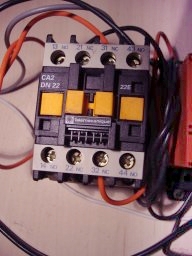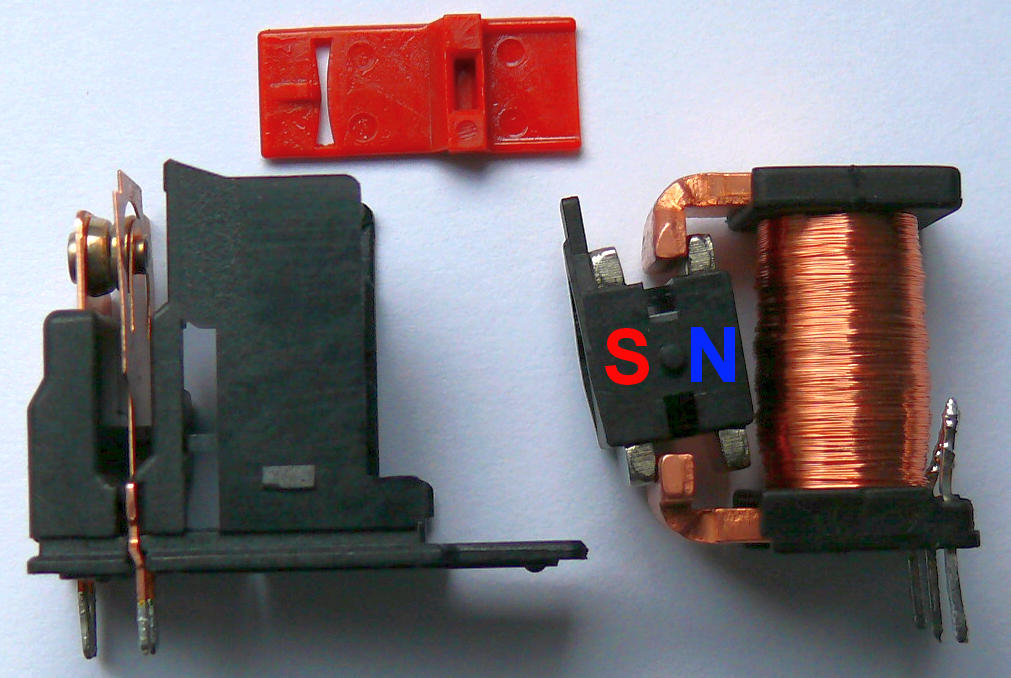|
Safety Relay
Safety relays are devices that generally implement safety functions. History Relays and contactors were used to control plant and machinery in the early days of control technology. In the event of a hazardous situation, the actuator was simply isolated from the energy supply. This type of protection system could be manipulated in the event of a malfunction, disabling the protective function. Special relay circuits, such as the three-contactor combination, were the first designs to come out of deliberations into how this could be avoided. These device combinations led to the development of the first safety relay from the German automation manufacturer Pilz, the PNOZ. Description In the event of a hazard, the task of safety functions (e.g. E-STOP, safety gate or standstill monitoring) is to use appropriate measures to reduce the existing risk to an acceptable level. These many safety functions include: * Emergency stop pushbuttons * Safety gates * Light beam devices * Pressu ... [...More Info...] [...Related Items...] OR: [Wikipedia] [Google] [Baidu] |
Relays
A relay Electromechanical relay schematic showing a control coil, four pairs of normally open and one pair of normally closed contacts An automotive-style miniature relay with the dust cover taken off A relay is an electrically operated switch. It consists of a set of input terminals for a single or multiple control signals, and a set of operating contact terminals. The switch may have any number of contacts in multiple contact forms, such as make contacts, break contacts, or combinations thereof. Relays are used where it is necessary to control a circuit by an independent low-power signal, or where several circuits must be controlled by one signal. Relays were first used in long-distance telegraph circuits as signal repeaters: they refresh the signal coming in from one circuit by transmitting it on another circuit. Relays were used extensively in telephone exchanges and early computers to perform logical operations. The traditional form of a relay uses an electromagnet to c ... [...More Info...] [...Related Items...] OR: [Wikipedia] [Google] [Baidu] |
Contactor
:''In semiconductor testing, contactors can also be referred to as the specialized socket that connects the device under test.'' :''In process industries, a contactor is a vessel where two streams interact, for example, air and liquid. See Gas-liquid contactor.'' A contactor is an electrically-controlled switch used for switching an electrical power circuit. A contactor is typically controlled by a circuit which has a much lower power level than the switched circuit, such as a 24-volt coil electromagnet controlling a 230-volt motor switch. Unlike general-purpose relays, contactors are designed to be directly connected to high-current load devices. Relays tend to be of lower capacity and are usually designed for both ''normally closed'' and ''normally open'' applications. Devices switching more than 15 amperes or in circuits rated more than a few kilowatts are usually called contactors. Apart from optional auxiliary low-current contacts, contactors are almost exclusively fitte ... [...More Info...] [...Related Items...] OR: [Wikipedia] [Google] [Baidu] |
Pilz (company)
Pilz GmbH & Co. KG is a German automation technology company in Ostfildern, Germany. In addition to the head office in Germany, Pilz is represented in 42 subsidiaries and branches on all continents. The company was founded as a glass-blowing business by Hermann Pilz in Esslingen in 1948. Initial products included glass apparatus for medical technology and mercury relays for industrial applications. In the 1960s control passed to Hermann's son Peter, who developed the company into a supplier of electronic control and monitoring devices and programmable logic controllers. In 1987 the company launched safety relay PNOZ, an emergency stop A kill switch, also known as an emergency stop (E-stop), emergency off (EMO) and as an emergency power off (EPO), is a safety mechanism used to shut off machinery in an emergency, when it cannot be shut down in the usual manner. Unlike a normal ... system. PSS control systems were developed in the 1990s. Other Pilz products and services inclu ... [...More Info...] [...Related Items...] OR: [Wikipedia] [Google] [Baidu] |
Kill Switch
A kill switch, also known as an emergency stop (E-stop), emergency off (EMO) and as an emergency power off (EPO), is a safety mechanism used to shut off machinery in an emergency, when it cannot be shut down in the usual manner. Unlike a normal shut-down switch or shut-down procedure, which shuts down all systems in order and turns off the machine without damage, a kill switch is designed and configured to abort the operation as quickly as possible (even if it damages the equipment) and to be operated simply and quickly (so that even a panicked operator with impaired executive functions or a bystander can activate it). Kill switches are usually designed to be noticeable, even to an untrained operator or a bystander. Some kill switches feature a removable, protective barrier against accidental activation (e.g. a plastic cover that must be lifted or glass that must be broken), known as a mollyguard. Kill switches are features of mechanisms whose normal operation or foreseeable ... [...More Info...] [...Related Items...] OR: [Wikipedia] [Google] [Baidu] |
Light Curtain
Light curtains was first introduced as a "Light barrier" by invertor Dr. Erwin Sick on Sept 26, 1972 when he formally described this device as "Safety devices acting in conjunction with the control or operation of a machine; Control arrangements requiring the simultaneous use of two or more parts of the body with means, e.g. feelers, which in case of the presence of a body part of a person in or near the danger zone influence the control or operation of the machine the means being photocells or other devices sensitive without mechanical contact using light grids" in a patent application in Germany. A year later, he followed up by also applying his patent idea in China, Italy, Japan, United States, Sweden and Great Britain. This invention substantially lowered the costs of safeguarding personnel without adversely affecting the high requirements of reliability and safety which were until than relied upon such screens. The "Light Barrier" screen was also of compact, neat design and ... [...More Info...] [...Related Items...] OR: [Wikipedia] [Google] [Baidu] |
Sensor
A sensor is a device that produces an output signal for the purpose of sensing a physical phenomenon. In the broadest definition, a sensor is a device, module, machine, or subsystem that detects events or changes in its environment and sends the information to other electronics, frequently a computer processor. Sensors are always used with other electronics. Sensors are used in everyday objects such as touch-sensitive elevator buttons ( tactile sensor) and lamps which dim or brighten by touching the base, and in innumerable applications of which most people are never aware. With advances in micromachinery and easy-to-use microcontroller platforms, the uses of sensors have expanded beyond the traditional fields of temperature, pressure and flow measurement, for example into MARG sensors. Analog sensors such as potentiometers and force-sensing resistors are still widely used. Their applications include manufacturing and machinery, airplanes and aerospace, cars, medicine, ... [...More Info...] [...Related Items...] OR: [Wikipedia] [Google] [Baidu] |
Actuator
An actuator is a component of a machine that is responsible for moving and controlling a mechanism or system, for example by opening a valve. In simple terms, it is a "mover". An actuator requires a control device (controlled by control signal) and a source of energy. The control signal is relatively low energy and may be electric voltage or current, pneumatic, or hydraulic fluid pressure, or even human power. Its main energy source may be an electric current, hydraulic pressure, or pneumatic pressure. The Control device is usually a valve. When it receives a control signal, an actuator responds by converting the source's energy into mechanical motion. In the ''electric'', ''hydraulic'', and ''pneumatic'' sense, it is a form of automation or automatic control. History The history of the pneumatic actuation system and the hydraulic actuation system dates to around the time of World War II (1938). It was first created by Xhiter Anckeleman who used his knowledge of engines and ... [...More Info...] [...Related Items...] OR: [Wikipedia] [Google] [Baidu] |
Relays
A relay Electromechanical relay schematic showing a control coil, four pairs of normally open and one pair of normally closed contacts An automotive-style miniature relay with the dust cover taken off A relay is an electrically operated switch. It consists of a set of input terminals for a single or multiple control signals, and a set of operating contact terminals. The switch may have any number of contacts in multiple contact forms, such as make contacts, break contacts, or combinations thereof. Relays are used where it is necessary to control a circuit by an independent low-power signal, or where several circuits must be controlled by one signal. Relays were first used in long-distance telegraph circuits as signal repeaters: they refresh the signal coming in from one circuit by transmitting it on another circuit. Relays were used extensively in telephone exchanges and early computers to perform logical operations. The traditional form of a relay uses an electromagnet to c ... [...More Info...] [...Related Items...] OR: [Wikipedia] [Google] [Baidu] |
Safety Equipment
Personal protective equipment (PPE) is protective clothing, helmets, goggles, or other garments or equipment designed to protect the wearer's body from injury or infection. The hazards addressed by protective equipment include physical, electrical, heat, chemicals, biohazards, and airborne particulate matter. Protective equipment may be worn for job-related occupational safety and health purposes, as well as for sports and other recreational activities. ''Protective clothing'' is applied to traditional categories of clothing, and ''protective gear'' applies to items such as pads, guards, shields, or masks, and others. PPE suits can be similar in appearance to a cleanroom suit. The purpose of personal protective equipment is to reduce employee exposure to hazards when engineering controls and administrative controls are not feasible or effective to reduce these risks to acceptable levels. PPE is needed when there are hazards present. PPE has the serious limitation that i ... [...More Info...] [...Related Items...] OR: [Wikipedia] [Google] [Baidu] |




